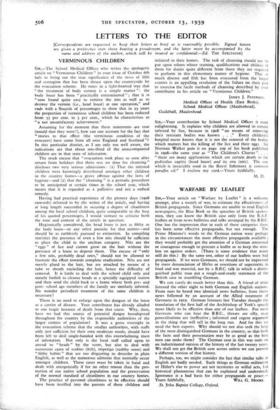LETTERS TO THE EDITOR
[Correspondents are requested to keep their letters as brief as is reasonably possible. Signed letters are given a preference over those bearing a pseudonym, and the latter must be accompanied by the name and address of the author, which will be treated as confidential.—Ed. THE SPECTATOR]
VERMINOUS CHILDREN
SIR,—The School Medical Officer who writes the apologetic article on " Verminous Children " in your issue of October 6th fails to bring out the true significance of the mass of filth and contagion that has been thrust upon the countryside by the evacuation scheme. He states in a light-hearted way that " the treatment of body vermin is a simple matter ": the body louse has been " practically exterminated " ; that it is " now found quite easy to remove the nits as well as to destroy the vermin (i.e., head louse) at one operation," and ends with a flourish of percentages to show that in 25 years the proportion of verminous school children has been reduced from 33 per cent. to 3 per cent., which he characterises as " a not unsatisfactory achievement."
Assuming for the moment that these statements are true (would that they were!), how can one account for the fact that " stories to that effect (the verminous condition of the evacuees) have come from all over England and Scotland "? In this particular district, as I am only too well aware, the indications are that about one-third of the unaccompanied children are in that state of infestation.
The stock excuse that " evacuation took place so soon after return from holidays that there was no time for cleansing" discloses two very serious admissions: (r) That the infested children were knowingly distributed amongst other children in the country homes—a grave offence against the laws of hygiene—and (a) that the " cleansing " is a periodic procedure to be anticipated at certain times in the school year, which means that it is regarded as a palliative and not a radical remedy.
Having had practical experience of the pioneer days (1908 onwards) referred to by the writer of the article, and having at long length succeeded in securing a degree of cleanliness among the local school children, quite comparable to the best of his quoted percentages, I would venture to criticise both the tone and content of the article in question.
Hygienically considered, the head louse is just as filthy as the body louse—or any other parasite for that matter—and should be as ruthlessly pursued to extinction. In compiling statistics the presence of even a few nits should be sufficient to place the child in the unclean category. Nits are the " eggs " of lice and cannot grow on the hair without the presence of a louse to deposit them. The excuse of " only a few nits, probably dead ones," should not be allowed to Frustrate the effort towards complete eradication. Nits are not merely glued to the hair, but are attached by means of a tube or sheath encircling the hair, hence the difficulty of removal. It is futile to deal with the school child only and merely foolish to cleanse heads at a specially equipped station and then send the child back to a home where both pre- and post- school age members of the family are similarly infested. No wonder periodical treatment of the same children is necessary!
There is no need to enlarge upon the dangers of the louse as a carrier of disease. Your contributor has already alluded to one tragic instance of death from that cause. Why, then, have we had this source of potential danger broadspread throughout the country by the responsible authorities of the larger centres of population? It was a gross oversight in the evacuation scheme that the smaller authorities, with staffs only just sufficient for their own moderate needs, should have been left to deal single-handed with this overwhelming mass of infestation. Not only is the local staff called upon to attend to " heads " by the score, but also to deal with numerous cases of scabies (itch), impetigo (scabby sores) and " filthy habits " that are too disgusting to describe in plain English, as well as the numerous ailments that normally occur amongst children. These cases must be taken in hand and dealt with energetically if for no other reason than the pro- tection of our native school population and the preservation of the normal standard of cleanliness in our country homes.
The practice of personal cleanliness to be effective should have been instilled into the parents of these children and initiated in their homes. The task of cleansing should not be put upon others whose training, qualifications and abilities in them for duties quite different from those they are required to perform in this elementary matter of hygiene. That so much disease and filth has been evacuated from the larger centres is an appalling revelation of the failure on their part to exercisa the facile methods of cleansing described by your contributor in his article on " Verminous Children."
JAMES J. PATERSON.
Medical Officer of Health (East Berks). School Medical Officer (Maidenhead). Guildhall, Maidenhead.
SIR,—Your contribution by School Medical Officer is most enlightening. It explains why children are allowed to remain infested by lice, because in 19o8 " no means of removing their resistant bodies was known . . ." Every children's hospital nurse knows that it is not the removal of the bodies which matters but the killing of the lice and their eggs. Sir Norman Walker puts it on page ro9 of his book published in 1908—the same year as " The Children's Charter ". . . . " there are many applications which are certain death to the pediculus capitis (head louse) and its ova (nits). The one which is invariably used in the Royal Infirmary is common paraffin oil." I enclose my card.—Yours faithfully,
M. D.










































 Previous page
Previous page